近年全球油气勘探中,深水领域占据了主导地位。2012—2019年,在新发现大型油气田个数和新发现油气储量中,深水领域占比分别约为50%和60%[1]。深水领域以其丰富的油气资源备受石油公司关注,成为勘探开发的热点[2-7]。东地中海为此类深水油气勘探的新兴地区之一,勘探活动活跃、成果显著,连续获得了Tamar、Leviathan、Zohr等发现,均为当年全球重大油气发现。黎凡特盆地、埃拉托色尼台地和希罗多德盆地作为东地中海的重要构造单元,处于深水—超深水区,勘探程度整体较低,具有可观的待发现油气资源和良好的油气勘探前景[8-9]。虽然这些构造单元具有相似的构造背景和演化过程,但发育的储盖组合、油气成藏模式及特征不尽相同,勘探程度差别也很大。前人有关东地中海构造特征、沉积充填、油气分布与成藏规律等研究以某一方面或单一盆地为主[10-14],急需针对该地区开展整体的区域地质、油气成藏特征研究,总结主要的深水油气富集条件,深化对该地区勘探潜力的认识,探讨未来的勘探方向,旨在为石油公司针对该地区勘探选区选带提供借鉴和参考。
1 区域概况东地中海处于北非、西亚和东南欧的交汇地带,主要包括黎凡特盆地、埃拉托色尼台地、希罗多德盆地等多个构造单元(图 1)。埃拉托色尼台地处于中心位置,分隔了东、西两侧的黎凡特盆地和希罗多德盆地,南临尼罗河三角洲盆地,北接塞浦路斯弧(图 2)。从深水油气勘探程度来看,黎凡特盆地和埃拉托色尼台地勘探程度较低,为勘探新兴区;希罗多德盆地尚无油气发现,为勘探前沿区。自2009年以来,东地中海先后发现了Tamar、Leviathan、Zohr等大气田,重大深水油气发现集中于黎凡特盆地和埃拉托色尼台地(表 1)。前者面积约为6.8×104km2,位于以色列和黎巴嫩境内,水深最深可达2300m;后者面积约为1.4×104km2,位于塞浦路斯境内,主体水深为1000~2000m。
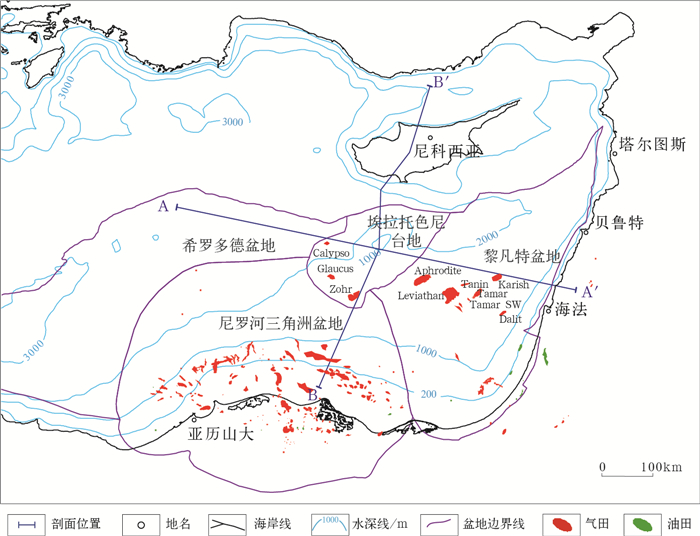
|
图 1 东地中海构造区划及油气田分布图 Fig. 1 Structural framework and distribution of oil and gas fields in the Eastern Mediterranean |
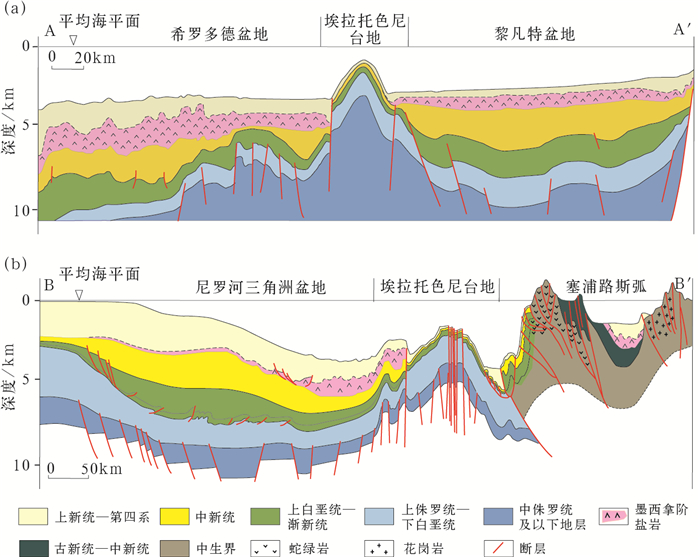
|
图 2 东地中海地质剖面示意图(据文献[15-18],有修改) Fig. 2 Schematic regional geological sections of the Eastern Mediterranean (modified after references [15-18]) |
| 表 1 东地中海主要油气田基本特征 Table 1 Features of the main oil and gas fields in the Eastern Mediterranean |
东地中海区域构造演化与潘基亚大陆裂解、新特提斯洋开合密切相关[10, 15],主要经历了3期构造演化阶段:三叠纪—中侏罗世裂谷期、晚侏罗世—晚白垩世早期被动大陆边缘期和晚白垩世中、晚期—现今构造反转期(图 3)。受裂谷期南北向拉张应力作用,埃拉托色尼陆块与阿拉伯板块分离,板块裂解及陆块漂移形成的伸展断层和转换断层控制了黎凡特盆地、尼罗河三角洲盆地和希罗多德盆地的雏形及边界[12, 16],该阶段以海陆过渡—浅海环境为主。被动大陆边缘期,深水盆地与陆块相间,沉积环境为浅海—半深海环境。构造反转期,南北向挤压作用使板块北侧俯冲、增生形成塞浦路斯弧和拉塔基亚冲断带,大量基底断层活化并发生强烈反转,埃拉托色尼陆块受压扭作用进一步隆升并演化为台地[22-24]。渐新世,古尼罗河水系发育并注入东地中海,深水盆地接受深海相碎屑岩沉积,埃拉托色尼台地以浅海台地相沉积为主[25]。中新世末期,地中海与中大西洋隔断,区域范围沉积了墨西拿阶盐岩。上新世,东地中海海平面上升,以远洋沉积为主。

|
图 3 东地中海主要构造单元地层对比(据文献[20-21],有修改) Fig. 3 Stratigraphic correlation chart for petroliferous basins in the Eastern Mediterranean (modified after references [20-21]) |
基于区域构造演化、沉积地层发育和油气勘探成果,认为渐新统—中新统半深海—深海相泥岩是东地中海最重要的烃源岩[26]。该套烃源岩广泛分布于深水盆地,有机质类型好,地球化学指标优越,但埋深较浅、成熟度不高,在后期低温还原环境下,生成生物成因气。邻区对比和盆地模拟结果显示,黎凡特盆地发育潜在的白垩系泥页岩和侏罗系泥灰岩成熟烃源岩,推测前者处于生油窗,后者进入了生干气阶段[27-29]。
2.2 储盖组合特征东地中海发育中新统生物礁灰岩+盐岩、中新统浊积砂岩+盐岩、白垩系浊积砂岩+泥页岩和侏罗系生物礁灰岩+泥灰岩4套储盖组合(表 2)。前两者为东地中海主力储盖组合,后两者为推测的储盖组合。
| 表 2 东地中海储盖组合基本特征 Table 2 Features of the reservoir-caprock assemblages in the Eastern Mediterranean |
截至2019年年底,在该储盖组合共发现4个气田,主要分布于埃拉托色尼台地,典型代表为Zohr气田。已发现探明+控制天然气储量为43.5×1012ft3。该储盖组合以渐新统—中新统半深海—深海相泥岩为烃源岩,储层为分布于埃拉托色尼台地周缘的中新统生物礁灰岩[23]。台地虽于中新世末—早上新世一度抬升、遭受剥蚀,但仅造成台地中央墨西拿阶盐岩缺失,其周缘盐岩盖层封闭条件良好[30]。烃源岩自中新世晚期大量排烃,源储侧向对接或沿活化的基底断层垂向短距离运移,聚集于台缘生物礁灰岩储层,成藏特征表现为“台缘礁体控储、源储侧向对接、上覆盐岩盖层”(图 4)。
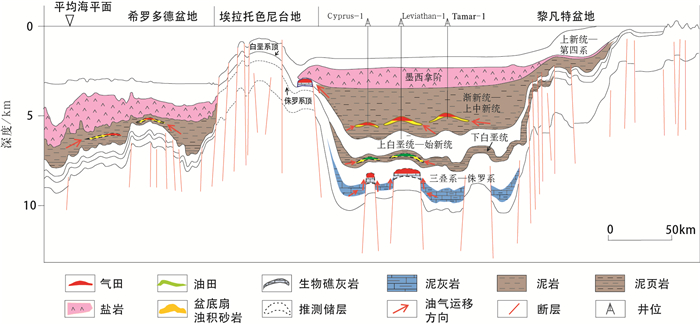
|
图 4 东地中海油气成藏模式图 Fig. 4 Hydrocarbon accumulation pattern in the Eastern Mediterranean |
截至2019年年底,于该储盖组合共发现11个气田,主要分布于黎凡特盆地深水区,典型代表为Leviathan气田和Tamar大气田。已发现探明和控制天然气储量为40.3×1012ft3,凝析油为68.2×106bbl,合计为7016.5×106bbl。该储盖组合以渐新统—中新统半深海—深海相泥岩为烃源岩,下中新统Tamar组浊积砂岩和墨西拿阶盐岩分别为储层和盖层[31]。中新世晚期,生成的生物成因气沿浊积砂岩短距离运移,聚集于中新世中、晚期构造反转形成的大型背斜、断背斜构造,成藏特征表现为“厚层砂体与大型背斜良好配置、盐层高效封盖”[26]。
希罗多德盆地深水区与黎凡特盆地具有类似的油气成藏条件,渐新统—中新统烃源岩和盐岩盖层在东地中海深水区广泛分布,古尼罗河水系控制的深水浊积体系在黎凡特盆地和希罗多德盆地深水区均有发育,形成优质的中新统浊积砂岩储层。推测希罗多德盆地同样发育中新统浊积砂岩+盐岩储盖组合。
2.2.3 白垩系浊积砂岩+泥页岩储盖组合该储盖组合为一套推测的储盖组合,发育于黎凡特盆地深水区,烃源岩为白垩系泥页岩,盖层为层间泥页岩。早白垩世海平面下降,陡坡区可见海退旋回界面,发育海底峡谷及盆底扇,形成白垩系浊积砂岩潜在储层[25]。推测白垩系烃源岩于渐新世—中新世排烃,构造反转期基底断层反转,地层受挤压形成背斜构造,油气沿砂层运移至白垩系储层成藏,表现为“浊积砂岩控储、砂层输导油气、构造控藏”的成藏特征。
2.2.4 侏罗系生物礁灰岩+泥灰岩储盖组合该储盖组合为黎凡特盆地深水区另一套推测的储盖组合。烃源岩为侏罗系泥灰岩,发育于裂谷期的地堑等局部凹陷,盖层为层间泥灰岩。晚侏罗世为浅海环境,裂谷期形成的地垒适宜生物礁发育,成为侏罗系生物礁灰岩潜在储层。推测侏罗系烃源岩于白垩纪末期开始排烃,油气由地堑沿基底断裂垂向运移至地垒之上的生物礁圈闭聚集成藏,表现为“生物礁灰岩控储、断层输导油气”的成藏特征。
3 深水油气富集主控因素 3.1 渐新统—中新统优质海相烃源岩奠定了优越的物质基础经过被动大陆边缘期持续的热沉降,东地中海以半深海—深海环境为主,沉积了巨厚的渐新统—中新统海相泥岩。在黎凡特盆地,该套泥岩最厚达1600m,有机质类型为Ⅱ2型,氢指数为300mg/g,生烃潜力为2mg/g,是一套优质烃源岩[31-32]。古尼罗河的发育导致地中海深水盆地地层沉积速率自渐新世起明显增大,形成了适宜生物甲烷生成的厌氧环境。同时,地温条件适宜,以黎凡特盆地为例,其为冷盆,地温梯度约为1.6℃/km,渐新世—中新世时30~60℃的地温条件是产甲烷菌最活跃的温度范围[33]。渐新统—中新统半深海—深海相泥岩厚度大、分布广、有机质类型好、地球化学指标优越,厌氧环境和适宜的古地温等提供了超强的生气与供气条件,为生物成因气的富集奠定了优越的物质基础。
3.2 古尼罗河水系和古台地控制了两类优质储层的发育深水盆地盆底扇浊积砂岩和台地边缘生物礁灰岩是研究区重要的两类储层,其发育及分布受控于古尼罗河水系和埃拉托色尼台地(图 5)[34]。
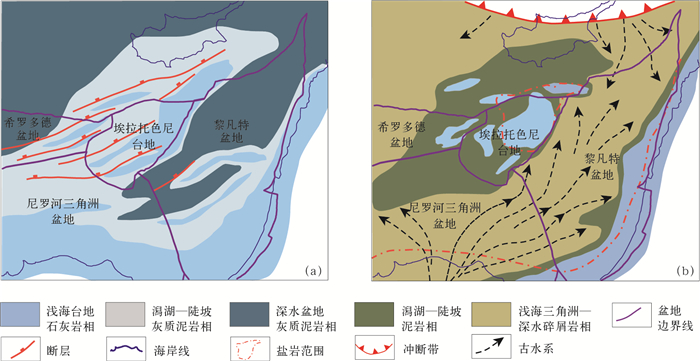
|
图 5 东地中海关键时期古地理图(据文献[34],有修改) Fig. 5 Paleogeographic maps in the Eastern Mediterranean (modified after reference [34]) (a)晚白垩世;(b)古近纪—新近纪 |
渐新世早期的构造隆升塑造了现今非洲主要的大型河流源汇系统,北非东部地区形成了自南向北注入东地中海的古尼罗河大型陆源沉积体系。渐新世—中新世,红海、埃塞俄比亚裂谷肩陆续发育,气候潮湿,大量陆源碎屑被搬运至东地中海,古尼罗河碎屑总沉积量达到3.86×105km3 [35-39]。该时期,东地中海构造单元受大型转换断层控制,强烈活化,形成高角度断裂陡坡坡折带。在陆源碎屑持续供给的背景下,碎屑经过陆架和陡坡坡折带后,堆积于坡脚并向深水盆地推进,形成大型盆底扇,分布于黎凡特盆地和希罗多德盆地深水区。古尼罗河深水浊积体系控制了下中新统Tamar组盆底扇浊积砂岩储层的发育。黎凡特盆地已证实该套浊积砂岩呈席状或朵叶状,由3套砂层组成,净厚度为30~140m,孔隙度为20%~25%,渗透率大于500mD,为厚层、高孔渗且连通性好的优质储层[40]。
古台地的主要形成时期为构造反转期,该阶段区域挤压应力占主导,板块俯冲、塞浦路斯弧隆起,大量基底断裂再次活动。埃拉托色尼陆块紧邻塞浦路斯弧,在其东西两侧北东—南西向基底断裂控制下,因压扭作用持续隆升,水体变浅,逐渐发育为台地。台地区陆源碎屑注入少、水质清洁,古气候温暖,有利于造礁生物生长,台地东侧、南侧和西侧紧邻深海一侧斜坡带广泛发育规模巨大的台地边缘生物礁,垂向生长厚度大,控制了优质中新统生物礁灰岩储层的发育。已发现的Zohr气田中新统生物礁灰岩储层净厚度达410m,气田规模达30×1012ft3 [23, 34]。
3.3 构造反转期区域挤压作用控制了大型构造圈闭的形成晚白垩世中、晚期—现今构造反转期,非洲与欧亚板块会聚,区域南北向挤压应力使基底断裂活化、发生反转,上覆地层强烈褶皱变形,形成大量与基底高角度反转断层相关的背斜、断背斜[16, 20, 24, 41]。这些背斜、断背斜的形态宽缓开阔且规模巨大,如黎凡特盆地Leviathan气田和Tamar气田面积分别为324km2和250km2 [20]。地震资料显示,此类宽缓背斜构造主要分布于黎凡特盆地深水区,展布受基底断层控制,长轴方向主要为北东—南西向[26]。挤压作用下形成的大型背斜构造为油气聚集提供了有利的圈闭条件。
3.4 区域性盐岩盖层是大型气田得以保存的关键中新世末期,随着欧亚板块不断会聚、碰撞,地中海与大西洋隔断,成为一个孤立的内海,补给中断、蒸发量大,海平面下降,沉积了墨西拿阶盐岩。该盐岩平均厚度为1500m,广泛发育于地中海深水区,空间分布具有很好的连续性,是一套优质的区域盖层[28, 42]。墨西拿阶盐岩与下伏中新统生物礁灰岩及Tamar组浊积砂岩储层形成了优越的储盖组合,为天然气的聚集提供了高效的封盖条件。稳定的、广泛分布的、厚层墨西拿阶区域性盐岩盖层是东地中海大型气田保存和富集的关键。
4 油气勘探方向东地中海的主要构造单元虽经历相同的构造演化阶段,但不同构造单元的勘探领域和油气聚集特征存在差异,勘探程度和已发现油气分布也不均衡。通过对东地中海储盖组合划分、成藏模式建立及油气富集条件分析,结合区域油气勘探发现情况,指出东地中海未来油气勘探的两个重点勘探区和两个远景目标区(图 6)。
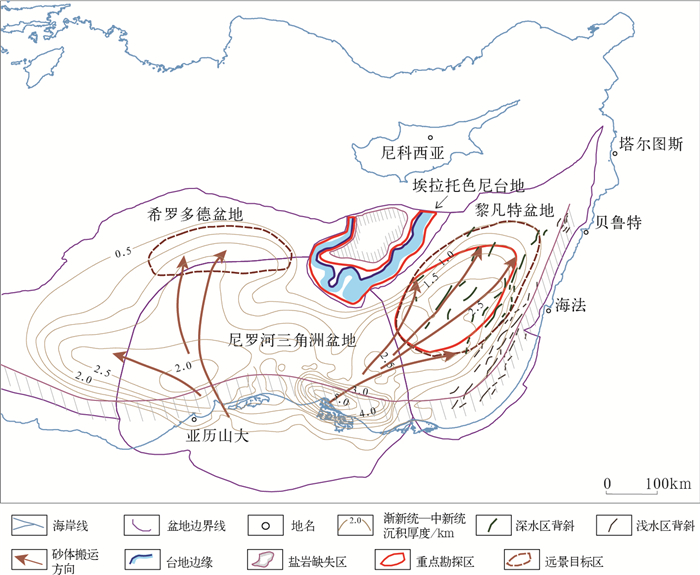
|
图 6 东地中海油气成藏有利区及勘探方向(据文献[28, 39, 41],有修改) Fig. 6 Favorable exploration targets in the Eastern Mediterranean (modified after references [28, 39, 41]) |
重点勘探区为黎凡特盆地中新统浊积砂岩领域和埃拉托色尼台地中新统生物礁灰岩领域,以上两个领域持续有大型气田发现,成藏条件优越,需重点关注。半深海—深海相泥岩为其提供充足的生物成因气;古尼罗河水系和埃拉托色尼台地分别控制了浊积砂岩储层和生物礁灰岩储层的发育;广泛分布的厚层区域性盐岩盖层为天然气富集提供了极为重要的封盖条件。黎凡特盆地深水区和埃拉托色尼台地东侧、南侧和西侧边缘分别为中新统浊积砂岩和生物礁灰岩的成藏有利区。
远景目标区为希罗多德盆地中新统浊积砂岩领域和黎凡特盆地中生界深层领域,上述领域勘探程度极低,尚无油气发现,但成藏条件好,勘探潜力大,具有可观的油气前景,值得持续探索和研究。前者油气地质条件与黎凡特盆地中新统浊积砂岩勘探领域类似,具有相同的烃源岩物质基础、古水系控储背景和优质区域盖层条件,深水勘探应集中于中新统浊积砂岩及反转构造发育区。后者为推测的深层勘探领域,中生界发育潜在成熟烃源岩、多类型储层和层间盖层,油气运聚条件匹配良好,裂谷期地垒构造高部位和被动大陆边缘期的深水盆地是其成藏有利区。
5 结论(1)东地中海发育中新统生物礁灰岩+盐岩、中新统浊积砂岩+盐岩、白垩系浊积砂岩+泥页岩和侏罗系生物礁灰岩+泥灰岩4套储盖组合。前两者分别为埃拉托色尼台地和黎凡特盆地主力储盖组合,成藏特征分别表现为“台缘礁体控储、源储侧向对接、上覆盐岩盖层”和“厚层砂体与大型背斜良好配置、盐层高效封盖”,类比分析认为希罗多德盆地为中新统浊积砂岩+盐岩储盖组合的潜在发育区;后两者为黎凡特盆地推测的储盖组合,油气成藏特征分别表现为“浊积砂岩控储、砂层输导油气、构造控藏”和“生物礁灰岩控储、断层输导油气”。
(2)东地中海深水油气富集条件包括:①渐新统—中新统优质海相烃源岩奠定了优越的物质基础;②古尼罗河水系和古台地控制中新统盆底扇浊积砂岩和生物礁灰岩两类优质储层的发育;③构造反转期区域挤压作用控制了大型构造圈闭的形成;④区域性盐岩盖层是大型气田得以保存的关键。
(3)东地中海深水重点勘探区是黎凡特盆地中新统浊积砂岩领域和埃拉托色尼台地生物礁灰岩领域,盆地深水区和台地周缘分别为其成藏有利区;未来值得探索的远景目标区是希罗多德盆地深水中新统浊积砂岩领域和黎凡特盆地中生界深层领域。
| [1] |
Wood Mackenzie[DB/OL]. [2020-10-27]. https://www.woodmac.com/.
|
| [2] |
张功成, 屈红军, 张凤廉, 等. 全球深水油气重大新发现及启示[J]. 石油学报, 2019, 40(1): 1-34. Zhang Gongcheng, Qu Hongjun, Zhang Fenglian, et al. Major new discoveries of oil and gas in global deepwaters and enlightenment[J]. Acta Petrolei Sinica, 2019, 40(1): 1-34. DOI:10.3969/j.issn.1001-8719.2019.01.001 |
| [3] |
谢玉洪, 高阳东. 中国海油近期国内勘探进展与勘探方向[J]. 中国石油勘探, 2020, 25(1): 20-30. Xie Yuhong, Gao Yangdong. Recent domestic exploration progress and direction of CNOOC[J]. China Petroleum Exploration, 2020, 25(1): 20-30. DOI:10.3969/j.issn.1672-7703.2020.01.003 |
| [4] |
刘合年, 史卜庆, 薛良清, 等. 中国石油海外"十三五"油气勘探重大成果与前景展望[J]. 中国石油勘探, 2020, 25(4): 1-10. Liu Henian, Shi Buqing, Xue Liangqing, et al. Major achievements of CNPC overseas oil and gas exploration during the 13th Five-Year Plan and prospects for the future[J]. China Petroleum Exploration, 2020, 25(4): 1-10. DOI:10.3969/j.issn.1672-7703.2020.04.001 |
| [5] |
王陆新, 潘继平, 杨丽丽. 全球深水油气勘探开发现状与前景展望[J]. 石油科技论坛, 2020, 39(2): 31-37. Wang Luxin, Pan Jiping, Yang Lili. Present conditions and prospect of global deepwater oil and gas exploration and development[J]. Petroleum Science and Technology Forum, 2020, 39(2): 31-37. DOI:10.3969/j.issn.1002-302x.2020.02.005 |
| [6] |
段瑞凯, 杨宝泉, 顾文欢, 等. 深水油田高效开发策略及实践[J]. 石油科技论坛, 2019, 38(5): 48-56. Duan Ruikai, Yang Baoquan, Gu Wenhuan, et al. Schemes and Practice of high-efficiency deepwater oilfield development[J]. Petroleum Science and Technology Forum, 2019, 38(5): 48-56. DOI:10.3969/j.issn.1002-302x.2019.05.009 |
| [7] |
张宁宁, 王青, 王建君, 等. 近20年世界油气新发现特征与勘探趋势[J]. 中国石油勘探, 2018, 23(1): 44-53. Zhang Ningning, Wang Qing, Wang Jianjun, et al. Characteristics of oil and gas discoveries in recent 20 years and future exploration in the world[J]. China Petroleum Exploration, 2018, 23(1): 44-53. DOI:10.3969/j.issn.1672-7703.2018.01.005 |
| [8] |
IHS Energy Group. International petroleum exploration and production database[DB/OL]. [2020-12-20]. http://www.ihs.com/products/oil-gas-information/data-access/geophysical-surveys/index.aspx.
|
| [9] |
U.S. Geological Survey. Assessment of undiscovered oil and gas resources of the Levant Basin province, Eastern Mediterranean[DB/OL]. [2010-3-12]. https://pubs.usgs.gov/fs/2010/3014/.
|
| [10] |
Delamotte D, Raulin C, Mouchot N, et al. The southernmost margin of the Tethys realm during the Mesozoic and Cenozoic: initial geometry and timing of the inversion processes[J]. Tectonics, 2011, 30(3): 1-22. |
| [11] |
刘小兵, 张光亚, 温志新, 等. 东地中海黎凡特盆地构造特征与油气勘探[J]. 石油勘探与开发, 2017, 44(4): 540-548. Liu Xiaobing, Zhang Guangya, Wen Zhixin, et al. Structural characteristics and petroleum exploration of Levant Basin in East Mediterranean[J]. Petroleum Exploration and Development, 2017, 44(4): 540-548. |
| [12] |
Netzeband G, Gohl K, Hübscher C, et al. The Levantine Basin: crustal structure and origin[J]. Tectonophysics, 2006, 418: 167-188. DOI:10.1016/j.tecto.2006.01.001 |
| [13] |
Segev A, Schattner U, Lyakhovsky V. Middle-Late Eocene structure of the southern Levant continental margin: tectonic motion versus global sea-level change[J]. Tectonophysics, 2011, 499: 165-177. DOI:10.1016/j.tecto.2011.01.006 |
| [14] |
Boudagher-Fadel M, Clark N. Stratigraphy, paleoenvironment and paleogeography of Maritime Lebanon: a key to Eastern Mediterranean Cenozoic history[J]. Stratigraphy, 2006, 3(2): 81-118. |
| [15] |
Gao Huahua, Tong Xiaoguang, Wen Zhixin, et al. The tectonic evolution of the eastern Mediterranean Basin and its control on hydrocarbon distribution[J]. Journal of Petroleum Science and Engineering, 2019, 178: 389-407. DOI:10.1016/j.petrol.2019.03.029 |
| [16] |
Tellus. Sinai-Levant Basin[DB/OL]. [2020-10-20]. http://robertson.cgg.com/.
|
| [17] |
Noble Energy. Investor presentation[DB/OL]. [2020-10-11]. https://www.nblenergy.com/.
|
| [18] |
Eni Energy. Eni golobal-presence[DB/OL]. [2020-10-11]. https://www.eni.com/en-IT/global-presence/africa.html.
|
| [19] |
Segev A, Sass E, Schattner U. Age and structure of the Levant Basin, Eastern Mediterranean[J]. Earth-Science Reviews, 2018, 182: 233-250. DOI:10.1016/j.earscirev.2018.05.011 |
| [20] |
Hawie N, Gorini C, Deschamps R, et al. Tectono-stratigraphic evolution of the northern Levant Basin (offshore Lebanon)[J]. Marine and Petroleum Geology, 2013, 48: 392-410. DOI:10.1016/j.marpetgeo.2013.08.004 |
| [21] |
Papadimitriou N, Gorini C, Nader F H, et al. Tectono-stratigraphic evolution of the western margin of the Levant Basin(offshore Cyprus)[J]. Marine and Petroleum Geology, 2018, 91: 683-705. DOI:10.1016/j.marpetgeo.2018.02.006 |
| [22] |
Gardosh M, Druckman Y, Buchbinder B, et al. The Levant Basin offshore Israel: stratigraphy, structure, tectonic evolution and implications for hydrocarbon exploration[R]. Jerusalem: Geological Survey of Israel, 2008: 1-125.
|
| [23] |
Hawie N, Deschamps R, Nader F H, et al. Sedimentological and stratigraphic evolution of northern Lebanon since the Late Cretaceous: implications for the Levant margin and basin[J]. Arab Journal Geoscience, 2014, 7: 1323-1349. DOI:10.1007/s12517-013-0914-5 |
| [24] |
田琨, 殷进垠, 王大鹏, 等. 黎凡特盆地油气地质特征与勘探方向[J]. 石油实验地质, 2020, 42(1): 95-102. Tian Kun, Yin Jinyin, Wang Dapeng, et al. Petroleum geology and exploration in Levant Basin, Eastern Mediterranean[J]. Petroleum Geology & Experiment, 2020, 42(1): 95-102. |
| [25] |
Wygrala B, Rottke W, Kornpihl D, et al. Assessment of controlling factors in mixed biogenic and thermogenic petroleum systems : a case study from the Levantine Basin [M]. Houston: AAPG Annual Convention and Exhibition, 2014.
|
| [26] |
Boudaher S, Ducros M, Michel P, et al. 3D thermal history and maturity modelling of the Levant Basin and its eastern margin, offshore-onshore Lebanon[J]. Arabian Journal of Geosciences, 2016, 9(440): 1-10. |
| [27] |
Boudaher S, Nader F H, Strauss H, et al. Depositional environment and source-rock characterization of organic-matter rich upper Santonian-upper Campanian carbonates, Northern Lebanon[J]. Journal of Petroleum Geology, 2014, 37(1): 5-24. DOI:10.1111/jpg.12566 |
| [28] |
Günes P, Aksu A E, Hall J. Internal seismic stratigraphy of the Messinian evaporites across the northern sector of the eastern Mediterranean Sea[J]. Marine and Petroleum Geology, 2018, 91: 297-320. DOI:10.1016/j.marpetgeo.2018.01.016 |
| [29] |
Tari J, Hussein H, Novotny B, et al. Play types of the deep-water Matruh and Herodotus Basins, NW Egypt[J]. Petroleum Geoscience, 2012, 18: 443-455. DOI:10.1144/petgeo2012-011 |
| [30] |
Feinstein S, Aizenshtat Z, Miloslavski I, et al. Genetic characterization of gas shows in the East Mediterranean offshore of southwestern Israel[J]. Organic Geochemistry, 2002, 33(12): 1401-1413. DOI:10.1016/S0146-6380(02)00184-5 |
| [31] |
贾怀存, 康洪全, 王春修, 等. 大型生物气田形成与富集条件研究——以东地中海黎凡特盆地为例[J]. 石油实验地质, 2018, 40(5): 699-704. Jia Huaicun, Kang Hongquan, Wang Chunxiu, et al. Accumulation conditions of large biogas fields in Levantine Basin, East Mediterranean[J]. Petroleum Geology and Experiment, 2018, 40(5): 699-704. |
| [32] |
Steinberg J, Gvirtzman Z, Folkman Y, et al. The origin and nature of the rapid late tertiary filling of the Levant Basin[J]. Geology, 2011, 39: 355-358. DOI:10.1130/G31615.1 |
| [33] |
Gvirtzman Z, Csato I, Granjeon D. Constraining sediment transport to deep marine basins through submarine channels: the Levant margin in the Late Cenozoic[J]. Marine Geology, 2014, 347: 12-26. DOI:10.1016/j.margeo.2013.10.010 |
| [34] |
Sagy Y. Tectono-sedimentary processes in the deep Levant Basin[R]. Jerusalem: Geological Survey of Israel, 2016: 1-136.
|
| [35] |
Bar O, Gvirtzman Z, Feinstein S, et al. Accelerated subsidence and sedimentation in the Levant Basin during the Late Tertiary and concurrent uplift of the Arabian platform: tectonic versus counteracting sedimentary loading effects[J]. Tectonics, 2013, 32(3): 334-350. DOI:10.1002/tect.20026 |
| [36] |
Gvirtzman Z. Gradual uplift and exposure of North Arabia and enhanced sedimentation in the Levant Basin during Neo-Tethys closure[R]. Jerusalem: Geological Survey of Israel, 2010: 1-24.
|
| [37] |
Macgregor D S. The development of the Nile drainage system: integration of onshore and offshore evidence[J]. Petroleum Geoscience, 2012, 18(4): 417-431. DOI:10.1144/petgeo2011-074 |
| [38] |
Needham D, Hosler J, Nowak S, et al. The Tamar Field from discovery to production [M]. Barcelona: AAPG European Regional Conference, 2013.
|
| [39] |
Esestime P, Hewitt A, Hodgson N. Zohr : a newborn carbonate play in the Levantine Basin, East Mediterranean[J]. First Break, 2016, 34: 87-93. |
| [40] |
Gardosh M, Druckman Y. Seismic stratigraphy, structure and tectonic evolution of the Levantine Basin, offshore Israel[J]. Geological Society of London Special Publication, 2006, 260: 201-227. DOI:10.1144/GSL.SP.2006.260.01.09 |
| [41] |
Skiple C, Anderson E, Fürstenau J. Seismic interpretation and attribute analysis of the Herodotus and the Levantine Basin, offshore Cyprus and Lebanon[J]. Petroleum Geoscience, 2012, 18: 433-442. DOI:10.1144/petgeo2011-072 |
| [42] |
Al-Balushi A N, Neumaier M, Fraser A J, et al. The impact of the Messinian salinity crisis on the petroleum system of the Eastern Mediterranean: a critical assessment using 2D petroleum system modelling[J]. Petroleum Geoscience, 2016, 22: 357-379. DOI:10.1144/petgeo2016-054 |




